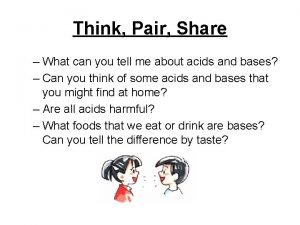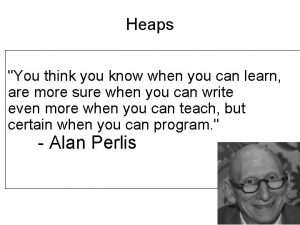Do you think that you can tell the



















- Slides: 19

• Do you think that you can tell the difference between Pepsi and Coke? Vs.

Warm-up • Find the least squares regression line: Test 1 Test 2 • What would you predict for Test 2 if a person made a 80 on Test 1? • What percent of variation in Test 2 can be explained by the least squares regression between Test 1 and Test 2? 67 72 58 63 38 54 98 95 78 84 84 89 88 90

P(Correct)= # Correct 0 1 2 3 Tally P(Correct)

DISCRETE AND CONTINUOUS VARIABLES Section 6. 1 A

Random Variable • Numerical variable whose value depends on the outcome in a chance experiment. • It connects a numerical value with each outcome.

Two types of numerical data • Discrete – collection of isolated points. Can be counted. • Continuous – includes an entire interval. Can be measured.

Identify as Discrete or Continuous. • The number of desks in the room. • The average height of all students. • The price of gasoline.

Examples of random variables. • # of keys on a key chain: 0, 1, 2, 3, … • # of heads when 2 coins are tossed: 0, 1, 2

What is the random variable and what type of variable is it? • Social worker involved in study about family structure – finds the number of children per family. • Archer shoots arrows at the bull’s eye and measures the distance from the center to the arrow.

Probability distribution • Model that represents the long-run behavior of the variable. • Gives the probability associated with each possible x-value. • Can be graphed as well.

Ex: Toss 3 coins. Let x = # heads

Ex: A box contains 4 slips of paper with $1, $10, $20 on them. The winner of a contest selects 2 slips and gets the sum of the 2 as her prize. Let x = possible amount won.

A company inspects products coming in. They receive computer boards in lots of five. Two boards are selected from each lot for inspection. Boards #1, 2 are defective. Let x = # defective boards.

We know that 10% of people who purchase cars buy manual transmissions and 90% purchase automatics. Three people purchase a car. Find the probability distribution for the number who purchase automatics.

35% of children wear contacts. Find the probability distribution for the number wear contacts in a group of four.

Properties of Probability Distribution • For every possible x value, • The sum of all possible probabilities is equal to 1.

Let x = # defects out of a lot of 10 parts x P(x) 0 1 2 0. 041 0. 13 0. 209 3 4 5 6 7 8 9 0. 223 0. 178 0. 114 0. 061 0. 028 0. 011 0. 004 10 0. 001 Find P(exactly 4) Find P(at least 8) Find P(at most 2) Find P(more than 6) Find P(4<x≤ 6)

• NC State released the grade distributions for online classes. For a specific class the students received 26% As, 42% Bs, 20% Cs, 10% Ds, 2% Fs. The grades are one a four—point scale where an A=4. Value of X: 0 1 2 3 4 Probability: 0. 02 0. 10 0. 20 0. 42 0. 26 1. What does P(X≥ 3) mean? 2. How would we write the equation if a student received a grade worse than a C? What is the probability?

Homework • Worksheet
 If you think you can you can poem
If you think you can you can poem Tell me what you eat and i shall tell you what you are
Tell me what you eat and i shall tell you what you are Ramaniklal ambani
Ramaniklal ambani You can tell harris about it just ____(easily) as i can.
You can tell harris about it just ____(easily) as i can. You can tell harris about it just ____(easily) as i can
You can tell harris about it just ____(easily) as i can You can tell harris about it just ____(easily) as i can
You can tell harris about it just ____(easily) as i can So you think you can argue
So you think you can argue So you think you can argue
So you think you can argue So you think you can argue
So you think you can argue Phân độ lown
Phân độ lown Block xoang nhĩ độ 2
Block xoang nhĩ độ 2 Thơ thất ngôn tứ tuyệt đường luật
Thơ thất ngôn tứ tuyệt đường luật Thơ thất ngôn tứ tuyệt đường luật
Thơ thất ngôn tứ tuyệt đường luật Chiến lược kinh doanh quốc tế của walmart
Chiến lược kinh doanh quốc tế của walmart Tìm vết của mặt phẳng
Tìm vết của mặt phẳng Con hãy đưa tay khi thấy người vấp ngã
Con hãy đưa tay khi thấy người vấp ngã Tôn thất thuyết là ai
Tôn thất thuyết là ai Gây tê cơ vuông thắt lưng
Gây tê cơ vuông thắt lưng Sau thất bại ở hồ điển triệt
Sau thất bại ở hồ điển triệt If you can imagine it you can achieve it
If you can imagine it you can achieve it



































